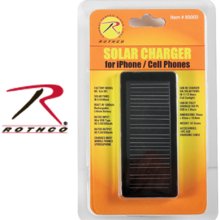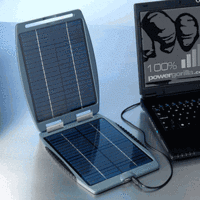
It will happen much as the tech revolution happened. Imagine if you could travel back in time, to 1970, and see the whole tech revolution unfold again.
You can. Open any web site or book describing tech history.
What you would find first is the development of small applications that can deliver value with chips like the Intel 4004, and a hobbyist market, a Heathkit group of gadget freaks anxious to not only buy but experiment with what they buy.
We have both. Ed Begley Jr. may be extreme, but there are lots of less-driven people out there, trying to minimize their "carbon footprint" and willing to invest both time and money in the effort. They are a small market today, but they're an important one. They're the acorn from which big opportunities grow.
For now, let's focus on the gadget idea. The idea of taking your iPhone or other all-electronic devices "off the grid" is not only appealing, not only possible, but it's already pretty cheap.
The Rothko Solar Charger, for instance, costs just $29 and is available from a host of online shops. I would not be surprised to see it at truck stops like Love's next time I drive across the country. (In the back, by the trucker's entrance.)
One product may be a gimmick, but the Rothko has lots of competitors. There's a real market here.
- The iceTech Solar 3000 costs $49 from Amazon and doubles as an iPhone carrier.
- The NovoThink NT01 costs $80 at Amazon and looks just like the plastic cover on my current Android phone.
- The Dermis univerSOL costs $38 and looks like a stand charger.
Most of these products are going through mainline channels like Amazon, Buy.Com and the like. There are also “environmental” stores like Greenlivingeveryday.com stocking them. Computer specialty shops also stock them. Look around next time you're at Fry's.

Thus solar laptop chargers come in many designs. Some are mats you unroll. I found one that looks like a George Foreman grill. Here's one that doubles as a laptop case.
The cheapest unit I found, from CECT (which I believe is a Chinese phone company), is available at Sears for $198.23 but can also charge other devices.
Discovery's Treehugger site recently did a round-up of such chargers they said were worth considering. They featured seven, with a variety of designs. Their “Best Buy” cost $620, and it's a 1.2 kg. mat (2.8 pounds) which starts the same size as an inch-thick (2.4 cm.) piece of paper, which you unroll, and it has an output of 26 watts. That's enough to power-up a laptop after sitting outside for 4-6 hours. The story says they found this unit online at just $390.
Just remember Moore's Law. The solar charger you buy this year may work well, but I can guarantee that the one you buy next year will deliver more watts, probably at lower cost, and the design may be more comfortable for you as well. The Kaypro I bought in 1982 looked and felt like the cases I had lugged tubes around in for my dad's Tower TV repair shop in the 1960s.
You measure the effectiveness of these things along several dimensions. There are, as yet, no standards.
-
Price – What does it cost, and what can I get it for?
-
Output – How many watts of power does it deliver, meaning how long will it take to get a useful charge out of it for my device.
-
Attractiveness – These things can look like anything, so this is highly subjective. But you want one that fits your lifestyle.
-
Usefulness – Most charge a wide variety of 6 volt devices. You want to see what kinds of connectors it has. The CECT, for instance, has USB out, a round plug like the one your cell phone charges in, and there are 29 different adapter tips.
-
Durability – These things are new so it's hard to tell about a useful life.
The bottom line is that you can select from among a broad line of solar chargers for most 6 volt devices right now. Gadgets for solar charging of hand-held devices are a growing business.
But that's not all.
Plug adapters

Energenie, a British company, offers a full line of plugs that cut-off the power when the device they're connected to doesn't need more. Many of them look like ordinary power strips. They have one that stands up and can handle 10 plugs for the equivalent of about $18 and for just a few pounds more you can have it with surge protection.
Careful before you buy a British version, of course. Plugs aren't standard. Neither are voltages. In the UK current comes out of the wall at about 230 volts, double the 1115 volts we use. When I travel I carry a collection of adapters and converters from Brookstone (or insert the name of your favorite store here).
The company which makes the Energenie has been around for a few years . As soon as an appliance goes into power standby mode, the plug automatically shuts off power to it. Note that this innovation is coming from a country where electricity costs more than it does here. High prices are a better incentive for innovation than low prices. Keeping electricity costs artificially low promotes waste and hampers the market for solutions.
The Energy Wizard, meanwhile, claims to do this automatically throughout your house. It claims savings of 10-23% on an electric bill. Of course it only works in the UK right now. There are b2b sites that claim to do this sort of thing on an industrial baseis..
Gadget sites are the folks who are leading the field. But the online world has a host of green energy stores, like this one, and review sites like the Green Energy Store . The field has become active enough that there is even an EnergyWizard site that warns of scams.
Organizing and advocating these new consumer markets, encouraging the market to build community, is the best contribution the Web can make to the green energy revolution right now. And it's happening.
More on that tomorrow.











Thanks for his very interesting post. This is really a good news for people who has a lot of gadgets. Charging this gadgets can prettily increase my monthly bills, but with this Solar Chargers, I could charge my iphone and even my laptop. Real Cool.
Thanks for his very interesting post. This is really a good news for people who has a lot of gadgets. Charging this gadgets can prettily increase my monthly bills, but with this Solar Chargers, I could charge my iphone and even my laptop. Real Cool.
Lana = Dana. Enough said 🙂
Lana = Dana. Enough said 🙂